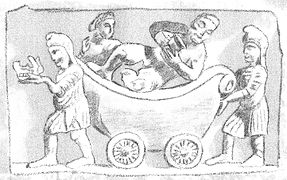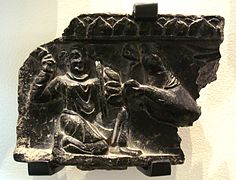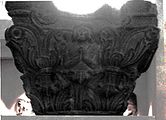Besides coinage, few works of art are known to indisputably represent Indo-Scythians. Indo-Scythian rulers are usually depicted on horseback in armour, but the coins of Azilises show the king in a simple, undecorated, tunic.[citation needed]
Several Gandharan sculptures also show foreigners in soft tunics, sometimes wearing the typical Scythian cap. They stand in contrast to representations of Kushan men, who seem to wear thick, rigid, tunics, and who are generally represented in a much more simplistic manner.[41]
Buner reliefs
Indo-Scythian soldiers in military attire are sometimes represented in Buddhist friezes in the art of Gandhara (particularly in Buner reliefs). They are depicted in ample tunics with trousers, and have heavy straight swords as weapons. They wear pointed hoods (the Scythian cap or bashlyk), which distinguishes them from the Indo-Parthians who only wore a simple fillet over their bushy hair,[42] and which is also systematically worn by Indo-Scythian rulers on their coins. With the right hand, some of them are forming the Karana mudra against evil spirits. In Gandhara, such friezes were used as decorations on the pedestals of Buddhist stupas. They are contemporary with other friezes representing people in purely Greek attire, hinting at an intermixing of Indo-Scythians (holding military power) and Indo-Greeks (confined, under Indo-Scythian rule, to civilian life).
Another relief is known where the same type of soldiers are playing musical instruments and dancing, activities which are widely represented elsewhere in Gandharan art: Indo-Scythians are typically shown as reveling devotees.
Stone palettes

Gandhara stone palette with Scythians playing music.
Numerous stone palettes found in Gandhara are considered good representatives of Indo-Scythian art. These palettes combine Greek and Iranian influences, and are often realized in a simple, archaic style. Stone palettes have only been found in archaeological layers corresponding to Indo-Greek, Indo-Scythian and Indo-Parthian rule, and are essentially unknown in the preceding Mauryan layers or the succeeding Kushan layers.[44]
Very often these palettes represent people in Greek dress in mythological scenes, a few in Parthian dress (head-bands over bushy hair, crossed-over jacket on a bare chest, jewelry, belt, baggy trousers), and even fewer in Indo-Scythian dress (Phrygian hat, tunic and comparatively straight trousers). A palette found in Sirkap and now in the New Delhi Museum shows a winged Indo-Scythian horseman riding winged deer, and being attacked by a lion.
The Indo-Scythians and Buddhism
The Indo-Scythians seem to have been followers of Buddhism, and many of their practices apparently continued those of the Indo-Greeks.
Royal dedications

The Bajaur casket was dedicated by Indravarman, Metropolitan Museum of Art.[45]
Several Indo-Scythian kings after Azes are known for making Buddhist dedications in their name, on plaques or reliquaries:
- Patika Kusulaka (25 BCE – 10 CE) related his donation of a relic of the Buddha Shakyamuni to a Buddhist monastery, in the Taxila copper plate.
- Kharahostes (10 BCE – 10 CE) is mentioned on the Buddhist Mathura lion capital and on a reliquary.[46][47] His coins were also found in the Bimaran casket, a beautiful Buddhist gold reliquary with an early image of the Buddha, now in the British Museum. Some of his coins bear the Buddhist triratna symbol.
- Vijayamitra (ruled 12 BCE - 15 CE) personally dedicated in his name a Buddhist reliquary.[48][49] Some of his coins bear the Buddhist triratna symbol.
- Indravarman, while still a Prince, personally dedicated in 5-6 CE a Buddhist reliquary, the Bajaur casket, now in the Metropolitan Museum of Art.
- Zeionises and Aspavarma also used the Buddhist triratna symbol on their coins.
- Rajuvula erected the Mathura lion capital, which incorporates Buddhist symbols and relates the donations by his wife of relics to a stupa.
Butkara Stupa

Buddhist stupas during the late Indo-Greek/Indo-Scythian period were highly decorated structures with columns, flights of stairs, and decorative Acanthus leaf friezes. Butkara stupa, Swat, 1st century BC.[50]
Excavations at the Butkara Stupa in Swat by an Italian archaeological team have yielded various Buddhist sculptures thought to belong to the Indo-Scythian period. In particular, an Indo-Corinthian capital representing a Buddhist devotee within foliage has been found which had a reliquary and coins of Azes buried at its base, securely dating the sculpture to around 20 BC.[52] A contemporary pilaster with the image of a Buddhist devotee in Greek dress has also been found at the same spot, again suggesting a mingling of the two populations.[53] Various reliefs at the same location show Indo-Scythians with their characteristic tunics and pointed hoods within a Buddhist context, and side-by-side with reliefs of standing Buddhas.[54]
Gandharan sculptures
Other reliefs have been found, which show Indo-Scythian men with their characteristic pointed cap pushing a cart on which is reclining the Greek god Dionysos with his consort Ariadne.[citation needed]
Mathura lion capital
The Mathura lion capital, which associates many of the Indo-Scythian rulers from Maues to Rajuvula, mentions a dedication of a relic of the Buddha in a stupa. It also bears centrally the Buddhist symbol of the triratana, and is also filled with mentions of the bhagavat Buddha Sakyamuni, and characteristically Buddhist phrases such as:
- "sarvabudhana puya dhamasa puya saghasa puya"
- "Revere all the Buddhas, revere the dharma, revere the sangha"
- (Mathura lion capital, inscription O1/O2)
Indo-Scythians in Western sources

"Scythia" appears around the mouth of the river Indus in the Roman period Tabula Peutingeriana.
The country of Scythia in the area of Pakistan, and especially around the mouth of the Indus with its capital at Minnagara (modern day Karachi) is mentioned extensively in Western maps and travel descriptions of the period. The Ptolemy world map, as well as the Periplus of the Erythraean Sea mention prominently, the country of Scythia on the Indus Valley, as well as Roman Tabula Peutingeriana. The Periplus states that Minnagara was the capital of Scythia, and that Parthian Princes from within it were fighting for its control during the 1st century AD. It also distinguishes Scythia with Ariaca further east (centred in Gujarat and Malwa), over which ruled the Western Satrap king Nahapana.
Indo-Scythians in Indian literature
The Indo-Scythians were named "Shaka" in India, an extension on the name Saka used by the Persians to designate Scythians. From the time of the Mahabharata wars (3100 BC roughly, prior to Kaiyuga start [58]) Shakas receive numerous mentions in texts like the Puranas, the Manusmriti, the Ramayana, the Mahabharata, the Mahabhasiya of Patanjali, the Brhat Samhita of Vraha Mihira, the Kavyamimamsa, the Brihat-Katha-Manjari, the Katha-Saritsagara and several other old texts. They are described as part of an amalgam of other war-like tribes from the northwest.










No comments:
Post a Comment